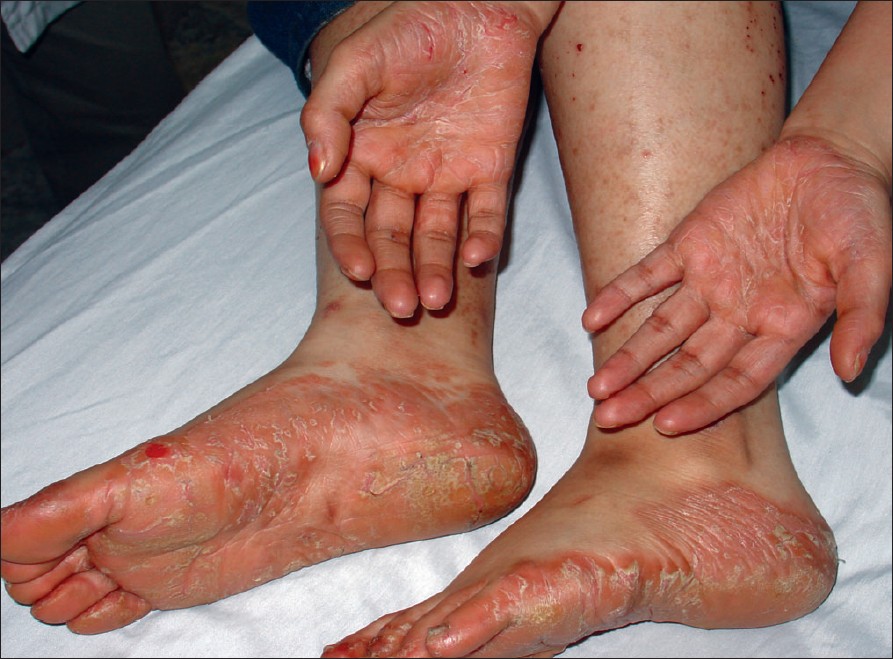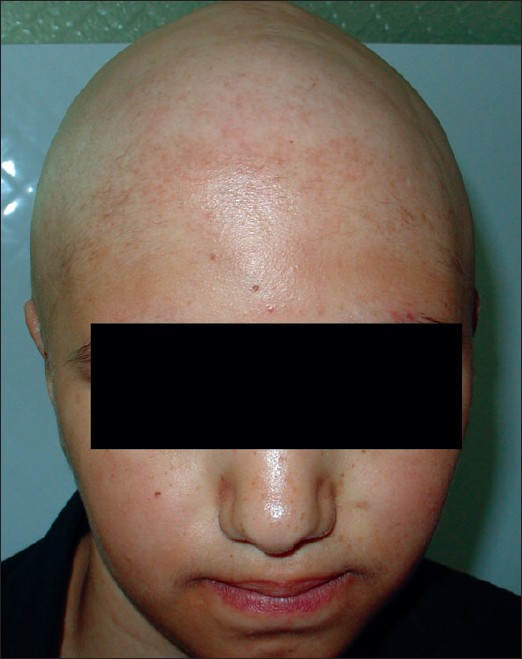Translate this page into:
Ectodermal dysplasia with alopecia, onychodysplasia, hypohidrosis, keratoderma, abnormal teeth and deafness
Correspondence Address:
Katrin Kiavash
Razi Hospital, Tehran University of Medical Sciences, Vahdate-Eslami Sq. 11966, Tehran
Iran
| How to cite this article: Akhyani M, Kiavash K. Ectodermal dysplasia with alopecia, onychodysplasia, hypohidrosis, keratoderma, abnormal teeth and deafness. Indian J Dermatol Venereol Leprol 2007;73:409-411 |
Abstract
The ectodermal dysplasias are a heterogeneous group of disorders with primary defect in hair, teeth, nail and sweat gland function. Numerous types have been described and several classifications exist. Here, we present a patient with ectodermal dysplasia with alopecia, dysplastic nails, hypohidrosis, sensorineural deafness, palmoplantar keratoderma, abnormal teeth and dry skin. To our knowledge, combination of all these features in ectodermal dysplasia has not been reported in the past. The etiology is unknown, but consanguinity of parents points to an autosomal recessive inheritance. |
| Figure 3: Prominent hyperkeratosis of palms and soles |
 |
| Figure 3: Prominent hyperkeratosis of palms and soles |
 |
| Figure 2: Finger and toe nails showing subungual hyperkeratosis and accentuation of longitudinal ridges and irregularities on the surface |
 |
| Figure 2: Finger and toe nails showing subungual hyperkeratosis and accentuation of longitudinal ridges and irregularities on the surface |
 |
| Figure 1: Total absence of scalp hair in our patient |
 |
| Figure 1: Total absence of scalp hair in our patient |
Introduction
The ectodermal dysplasias are heterogeneous heritable developmental disorders with ectodermal manifestations and defects affecting other organs and tissues. [1] The main manifestations include defects in hair, teeth, nail and sweat gland functions. These disorders are clinically divided into hidrotic and anhidrotic forms and each of these forms is subdivided into different syndromes based on the presence or absence of hair defects, tooth abnormalities, nail deformities, deafness, palmoplantar keratoderma and other features.
The number of ectodermal dysplasia syndromes has increased to more than 170 syndromes. [2] Here, we present a patient with ectodermal dysplasia with features that, to our knowledge, have not been reported in the past.
Case Report
Our patient was a 21-year-old Iranian girl who presented with hyperkeratosis affecting her palms and soles since she was 15 years old. She was born of a normal delivery and her psychomotor development was normal. In infancy, she had sparse and fine scalp hair and abnormal nails. Her hair remained sparse despite various treatments and she became totally bald at the age of 4 years. Her temporary teeth were abnormal in number and shape and were lost early. She had abnormal permanent teeth and had to use dentures in place of her lost teeth from the age of 12 years. In early childhood, her parents noted her hearing problem. Investigations showed complete sensorineural deafness in her right ear and partial sensorineural deafness in her left ear. She gave history of heat intolerance and hypohidrosis from early childhood. She had normal intelligence and was a college student. She had no history of seizure disorder or any other significant illness.
Examination revealed teeth abnormalities including malformed teeth, early caries and tooth loss that necessitated the use of a denture. Hair abnormalities included sparse eyelashes and eyebrows with total absence of scalp hair [Figure - 1]. The pubic and axillary hair were sparse and other terminal hairs on the trunk and limbs were absent. Examination of her finger and toe nails showed subungual hyperkeratosis, onycholysis and accentuation of longitudinal ridges and irregularities on the surface, especially on her toes [Figure - 2]. Scrapping for dermatophytes of the nail was negative. Her skin was dry and rough. Areas of follicular keratosis were evident on her back and legs. Palmoplantar keratoderma was prominent [Figure - 3]. It was diffuse, severe and transgradient. Histopathological examination of plantar skin showed hyperkeratosis, focal parakeratosis, acanthosis and spongiosis. Mild perivascular lymphocytic infiltration in papillary and superficial dermis was also evident. There was no psoriasiform reaction pattern. Ophthalmologic examination was also normal. Neurological examination revealed no abnormality and her speech was normal.
She was the third child of her consanguineous (second degree relatives) parents. Examination of her parents, her two elder brothers and her younger sister showed no sweating deficiency and no hair, nail or teeth abnormalities.
Discussion
Ectodermal dysplasias constitute a complex group of diseases characterized by various defects in hair, nails, teeth and sweat glands. Several classifications exist. Freire-Maia and Pinheiro have proposed a classification based on the involved ectodermal derivative. In this classification, ′1′ indicates hair dysplasia, ′2′ dental dysplasia, ′3′ nail dysplasia and ′4′ sweat gland dysplasia. [3] Based on this, there are more than ten subgroups in Freire-Maia and Pinheiro classification. [1] Since our patient had abnormality in hair, teeth, nail and sweat gland function, her ectodermal dysplasia fits in 1-2-3-4 subgroup. Abnormalities in hair, teeth and nail were obvious. Since she complained of hypohidrosis and intolerance to heat and warm weather and her skin was dry and rough, we did not perform iontophoresis test to confirm the abnormality of sweat gland function.
There are various syndromes in 1-2-3-4 subgroup and differentiation of these syndromes is based on additional components. Sensorineural deafness and palmoplantar keratoderma are the main additional components in our patient. Sensorineural hearing defect is a component of many ectodermal dysplasias and is probably the consequence of mutation in GJB6. [4] In contrast, palmoplantar keratoderma is seen in limited ectodermal dysplasia syndromes. [5] The most closely-similar syndrome resembling our patient is Greither-type ectodermal dysplasia with hypohidrosis, total alopecia, loss of teeth, dystrophic nails and transgradient form of palmoplantar keratoderma but with corneal and lenticular opacities that our case lacks. [6] Patients with Greither-type ectodermal dysplasia also lack sensorineural hearing defect. Tricho-onychodental dysplasia is another syndrome in 1-2-3-4 subgroup with taurodontic molars, dentine and nail dysplasia and hypohidrosis. Absence of palmoplantar keratoderma and sensorineural hearing defect differentiate this syndrome from our patient. [7] Although palmoplantar keratoderma has been reported in a case with Rapp-Hodgkin syndrome, [8] absence of sensorineural hearing defect and presence of cleft palate differentiate this syndrome from our patient. Other syndromes in 1-2-3-4 subgroup also differ from our patient in presence of additional signs and lack of palmoplantar keratoderma.
Another syndrome closely resembling our patient′s is a case of ectodermal dysplasia syndrome with alopecia, onychodysplasia, hypohidrosis, hyperkeratosis, deafness and other manifestations reported by Freire-Maia et al. [9] Although this syndrome has been classified in 1-2-3-4 subgroup, [10] the original paper has classified this syndrome in 1-3-4 subgroup because of normal teeth. [9] Patients with Clouston′s syndrome also have prominent palmoplantar keratoderma, but sweat gland function is normal. [11]
Since we were unable to find an exact match to our patient in literature, we consider alopecia, onychodysplasia, hypohidrosis, deafness, abnormal teeth and palmoplantar keratoderma with normal cornea to be a separate entity in the 1-2-3-4 subgroup of Freire-Maia. The cause is unknown, but consanguinity of parents points to autosomal recessive inheritance.
| 1. |
Itin PH, Fistarol SK. Ectodermal dysplasias. Am J Med Genet C Semin Med Genet 2004;131C:45-51.
[Google Scholar]
|
| 2. |
Lamartine J. Towards a new classification of ectodermal dysplasias. Clin Exp Dermatol 2003;28:351-5.
[Google Scholar]
|
| 3. |
Pinheiro M, Freire-Maia N. Ectodermal dysplasias: A clinical classification and a causal review. Am J Med Genet 1994;53:153-62.
[Google Scholar]
|
| 4. |
Lamartine J, Munhoz Essenfelder G, Kibar Z, Lanneluc I, Callouet E, Laoudj D, et al . Mutations in GJB6 cause hidrotic ectodermal dysplasia. Nat Genet 2000;26:142-4.
[Google Scholar]
|
| 5. |
Kamlesh K, Garg KR, Barisal PP, Dewan KN. Anhidrotic ectodermal dysplasia with palmo-plantar keratoderma. Indian J Dermatol Venereol Leprol 1982;48:352-4.
[Google Scholar]
|
| 6. |
Greither A, Tritsch H. About a case of anhidrotischer ektodermalar dysplasia with almost Complete Alopecie, transgredienten Palmar-Plantar- keratoses, macular degeneration other break other Augenstorungen, Zaha of anomalies and a Pseudo-Klinfelter-Syndrome. Arch Klin Exp Dermatol 1963;216:50-62.
[Google Scholar]
|
| 7. |
Koshiba H, Kimura O, Nakata M, Witkop CJ Jr. Clinical, genetic and histologic features of the trichoonychodental (TOD) syndrome. Oral Surg Oral Med Oral Pathol 1978;46:376-85.
[Google Scholar]
|
| 8. |
O'Donnell BP, James WD. Rapp-Hodgkin ectodermal dysplasia. J Am Acad Dermatol 1992;27:323-6.
[Google Scholar]
|
| 9. |
Freire-Maia N, Cat I, Raponegaidzinski R. An ectodermal dysplasia syndrome of alopecia, onychodysplasia, hypohidrosis, hyperkeratosis, deafness and other manifestations. Hum Hered 1977;27:127-33.
[Google Scholar]
|
| 10. |
Harper JI, Trembath RC. Genetics and genodermatoses. In : Burns T, Breathnach S, Cox N, Griffiths C, editors. Rook's textbook of dermatology. 7 th ed. Turin: Blackwell publishing;2004: p. 12.40-12.56.
th ed. Turin: Blackwell publishing;2004: p. 12.40-12.56.'>[Google Scholar]
|
| 11. |
Clouston HR. A hereditary ectodermal dystrophy. Can Med Assoc J 1929;21:18-31.
[Google Scholar]
|
Fulltext Views
4,080
PDF downloads
2,243





